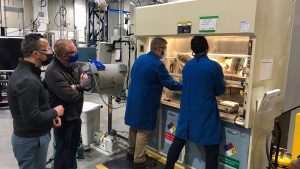Robert Taylor, Deputy Office Director for New Reactors at the U.S. Nuclear Regulatory Commission, discusses the regulatory challenges brought about by the rise of small modular reactors and advanced designs.
Our mission at the Nuclear Regulatory Commission is licensing and regulating US civilian uses of radioactive materials. We do that so we are reasonably sure those uses adequately protect public health and safety, as well as the environment, while promoting the country’s common defense and security. For the new and advanced designs the industry is currently considering, we ensure the new technology meets the requirements for safe operation and that environmental impacts are deemed acceptable. We are implementing our strategic plan to be an efficient and effective regulator using risk-informed decision making.
Small modular and advanced reactors
Our current focus on small modular and advanced reactors stems from interest in these designs from industry vendors, utilities, government agencies, congress, and other international regulators. Small modular reactors (SMRs) and advanced designs (cooled by substances other than water) could fill applications ranging from power generation to process heat, desalination, and other industrial uses. Government entities are considering SMRs and advanced reactors for purposes including military and space applications. Industry and government agencies also see these reactors as a source of carbon-free energy. Lastly, international regulators and organisations (e.g., the Canadian Nuclear Safety Commission, the International Atomic Energy Agency, and the Nuclear Energy Agency) are interested in co-operating with us to improve and enhance licensing activities and to ensure the safety of these technologies.
Commercial SMRs and advanced designs present a challenge in applying the current regulatory framework, which was developed based on large light-water reactor (LWR) technology. We are prepared and able to review new applications under title 10 of the Code of Federal Regulations (CFR) Parts 50 and 52 using existing regulatory tools, such as exemptions, orders, license conditions, and technology-inclusive guidance, such as the Licensing Modernization Project.
The staff have also made significant progress developing a new regulatory framework, 10 CFR Part 53, in accordance with the Nuclear Energy Infrastructure Modernization Act (NEIMA). Part 53 is technology-inclusive, risk-informed, and performance-based, allowing us to enhance the effectiveness and efficiency of our regulatory reviews of new technologies that may be submitted. The framework also recognises technological advances in reactor design and allows credit in the form of operational flexibilities when an advanced reactor design can show increased margins of safety, including slower transient response times and relatively small and slow releases of radioactive material during a potential accident.
New developments
New fuel designs and reactor materials present additional technical challenges, so the NRC has recently developed guidance in these areas including NUREG-2246, “Fuel Qualification for Advanced Reactors, Final,” and Draft Regulatory Guide (DG) 1380 (RG 1.87 Revision 2), “Acceptability of ASME Section III, Division 5, High Temperature Reactors,” for high temperature materials.
We aim to be as efficient a regulator as possible, so we have been working on many regulatory improvements for SMRs and advanced designs. In addition to the Part 53 effort, other transformative rulemakings underway include:
- Alternative Physical Security Requirements for Advanced Reactors;
- Emergency Preparedness Requirements for Small Modular Reactors and Other New Technologies; and
- Advanced Nuclear Reactor Generic Environmental Impact Statement (GEIS).

We have also been proactively identifying and resolving technology-inclusive policy issues for advanced reactors for several years. For example, regulatory improvements and progress can be found in the areas of Functional Containment Performance (SECY-18-0096), where advanced fuels and coolants help keep radioactive material within the reactor if something goes wrong. This is also true in Population Related Siting Considerations for Advanced Reactors (SECY-20-0045), where advanced designs’ safety features and smaller core sizes can affect where a nuclear power plant can be placed in relation to towns and small cities.
Additional guidance helps the industry develop license applications for advanced reactors under the current regulatory framework and to support the staff’s risk-informed and safety-focused review. This guidance includes:
- Regulatory Guide 1.232 on Advanced Reactor Design Criteria;
- Regulatory Guide 1.233 on the Licensing Modernization Project;
- A soon-to-be-issued draft Advanced Reactor Content of Application (ARCAP) Guidance for public comment. This technology-inclusive, risk-informed, and performance-based application guidance will help near-term applicants under the current regulatory framework; and
- Trial Regulatory Guide 1.247 endorsing a risk analysis standard for advanced designs.
Ongoing specific licensing activities include the NuScale SMR. The NRC issued a standard design approval for this design in September 2020 and is completing a rule to formally certify the NuScale reactor for US use. The NRC is also reviewing a construction permit application for a test version of the Kairos Hermes advanced reactor, proposed to be constructed in Oak Ridge, Tennessee. The NRC is also in preapplication discussions with several other SMR and advanced reactor developers.
The NRC performs its reviews independently, applying the highest standards of safety and rigor before issuing licensing and oversight decisions that adequately protect public health and safety and the environment.
With transformational change taking place at both the NRC and in the nuclear industry with advanced reactors, we have been strongly encouraging potential applicants to engage with us as openly and as early as possible. This is a crucial cornerstone to ensure novel designs and approaches are well understood prior to an applicant formally submitting a design or license for review. We are also improving our regulatory efficiency through the NuScale Lessons Learned Report, implementing innovative strategies to conduct effective and efficient licensing reviews. These improvements include dedicated, interdisciplinary review teams; ensuring quality of requests for additional information; expanding use of regulatory audits; streamlining the staff’s safety evaluation reports; and using a new, flexible integrated review schedule.
The NRC’s role in SMR and advanced reactor deployment is limited to making appropriate licensing and oversight decisions that will meet our mission of protecting public health and safety. As I mentioned earlier, we are ready and able to review applications under Parts 50 and 52 using existing regulatory tools to perform custom reviews that are tailored to the technologies and licensing requests of applicants. If we conclude designs meet our requirements and that we can issue licenses to build and operate a reactor, the ball lands in the industry’s court. Investment costs, construction times, and other economic factors that influence the deployment of advanced reactors are outside of the NRC’s control.
Robert Taylor
Deputy Office Director for New Reactors
Office of Nuclear Reactor Regulations
U.S. Nuclear Regulatory Commission
www.nrc.gov
https://www.linkedin.com/company/u-s–nuclear-regulatory-commission/
https://www.facebook.com/nrcgov/
https://twitter.com/nrcgov
Please note, this article will also appear in the eleventh edition of our quarterly publication.









